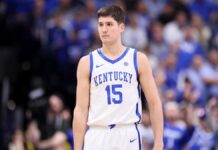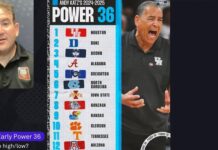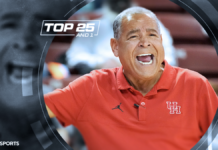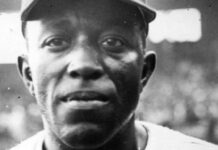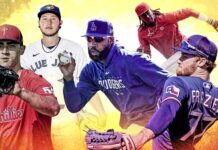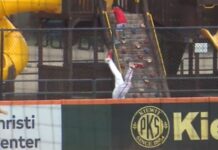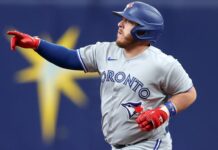Here are the 2021 guaranteed-to-be-right-as-long-as-you-don’t-check-back-a-year-from-now hitting sleepers, as comprised by a combination of “interesting analytical data” and “gut feel,” which is really all you can do in these cases. These players haven’t yet had full-season breakouts, and a glimpse at surface-level stats may or may not cause them to be that interesting. We think they’re interesting, though, for reasons we’ll soon share. We think they can help their teams win, or at least improve.
Now: What’s a sleeper anyway? If you’re reading this because you’re in a deep keeper fantasy league and you’re already eyeing the best rookies of 2034, then you probably already know these names. If you’re my dad, you probably don’t. (Hi, dad!)
So, we’re going with a simple pair of qualification rules: 1) You can’t have ever been a Top 50 prospect, per MLB Pipeline, because recent top prospects don’t feel like “sleepers,” and 2) You can’t have already had a full, above-average hitting season in the bigs (which we’re defining as 500 plate appearances with an OPS + of 100 or higher). Anyone else is fair game. (Mostly. Technically, Lourdes Gurriel Jr., who we like very much, has not done this. But he feels too established to count.)
Here are five who stand out to us:
Rowdy Tellez, 1B/DH, Blue Jays
It’s not like Tellez hasn’t already had his moments, of course. Over parts of three seasons with the Blue Jays, he’s got a 111 OPS+, meaning he’s been about 10% better than average. He’s also shown some elite-quality power. In 2019, his barrel rate was in the top 10% of qualifiers; on Tuesday, he hit balls 113 and 110.5 mph; over the past two seasons, he’s one of just five players with a home run hit at 117 mph or more, when he did this to poor Vince Velasquez last August:
So why hasn’t he stuck as an everyday player yet? Partially because he’s a decent-but-not-high-quality defender at first base. Partially because his 2020 was interrupted by a knee injury. And, partially, because of the strikeouts, which came in at a higher-than-average 28% in both 2019 and ’20. (In 2019, despite the power, he had a mere 95 OPS+.) It’s tempting to say his 139 OPS+ from last year was his real breakout, but it also came in only 127 plate appearances. We’d like to see something to point to behind it.
Something like, perhaps, baseball’s biggest plate discipline change. No qualified player in baseball cut his strikeout rate by as much as Tellez did, and ahead of some impressive names:
1) -12.7% (Rowdy Tellez, from 28.4% to 15.7%)
2) -8.6% (Wil Myers)
3) -8.5% (Bryce Harper)
4) -6.5% (Eric Hosmer)
5) -6.1% (Kyle Seager)
Itt’s encouraging, also, to look back on this article from MLB.com’s Keegan Matheson from February 2020, where Tellez made it very clear that working with former big leaguer Dante Bichette — yes, Bo’s dad — had helped with his mental approach. Tellez still doesn’t have a terribly clear path to playing time, not with Vladimir Guerrero Jr. likely playing first base, and with an overstuffed outfield taking up some of the DH time. But if Tellez’s approach changes are real, that won’t matter. They’ll make room.
Josh Rojas, 2B/UT, D-backs
We’ll admit to some personal interest here, because back in 2019, we went with a duct-taped method to try to identify the next Mike Tauchman, and came up with four hitters for 2020 — one of whom became breakout Padre Trent Grisham. One of the others was Rojas, who was drafted by Houston as a 26th-rounder in 2017 and was dealt to Arizona in the 2019 Zack Greinke trade. In 17 games for the D-backs in 2020, he didn’t do much to pay off that faith, hitting .180/.257/.180.
This winter, he went to change … everything. “I changed my diet. I changed my sleep habits. I changed how hard I was lifting,” he told MLB.com earlier in March. “I also started swinging a lot earlier. I started working with [D-backs hitting coaches] probably at the beginning of January — a little bit in December, but really picked it up in January.”
On Tuesday, D-backs manager Torey Lovullo noted that Rojas had changed his setup at the plate, as well. “He went back to the drawing board with his setup,” Lovullo told MLB Network Radio. “With Josh, it’s done nothing but enhance his ability to do what he’s trying to do.”
It’s worth not getting too excited about the .381/.436/.686 Spring Training line (through Thursday), because … it’s Spring Training. But it is worth being thankful that the D-backs play in the only Statcast-enabled park in the Cactus League, because this spring, Rojas has already hit a ball harder (a 109.9 mph double against the Cubs) than he’d had in either the 2019 or ‘20 regular seasons. There’s some research that suggests setting a new max exit velocity threshold — which, of course, takes all of one batted ball — is meaningful, especially north of 108 mph. So far, and keeping in mind that only about a third of the teams play in Statcast-enabled Spring Training ballparks, only four players have more balls hit at 100 mph this spring.
Rojas is likely to get a chance at second and/or the outfield this year, and the Arizona lineup would take the help wherever it can get it.
DJ Stewart, OF/DH, Orioles
Here’s a chart that might look complicated, but it’s also pretty useful. On the vertical axis, you have barrel rate, with a “barril” basically being the perfect combination of exit velocity y launch angle. (You want lots of these, obviously.) On the horizontal axis, you have wOBA, which is similar to OPS. Unsurprisingly, there’s a noticeable relationship there; hit the ball in the air, and production probably comes with it.
Look at the names immediately around Stewart’s. To use a scientific term: Those are some dudes.
Why, then, is Stewart not a dude? Injuries, somewhat. (Well, that, and a potentially fatal inability to hit fastballs; he was 4-for-65 against them last year.) In 2019, he injured his ankle colliding with infielder Hanser Alberto in June, which cost him a month, and then in his very first game back, he suffered a concussion on an unfortunately infamous fielding miscue. Then in October, he required microfracture surgery to repair the ankle. Like Tellez, his best position is “DH,” though he’s in the mix for outfield time too, especially if Trey Mancini mostly sticks to first base.
But what Stewart can do, at a potentially very good level, is draw a walk. In 2020, he had a 17.9% walk rate, and among hitters with 100 plate appearances, only six batters did better. (Names? Oh, there’s names. Juan Soto, Harper, Aaron Hicks, Ronald Acuña Jr., Christian Yelich, Carlos Santana. That’s it.) That’s how, despite a mere .193 batting average, he had a 121 OPS+ — he got on base and hit for power. In the Minors, in more than 2,110 plate appearances, he had a walk rate of nearly 13%. It’s a thing he can do.
Which leads us to another chart, which … well, look. This one compares barrel rate and walk rate, and “hit the ball hard in the air” plus “draw lots of walks” seems like a good thing, right? That’s why some of the truly elite hitters in baseball are all grouped together, and hey look, there’s also DJ Stewart; no, we can’t believe this is a chart that exists either. And yet: it does.
We feel like we need to be explicitly clear here: Stewart is not, and will never be, ever, Soto, or Harper, or Freddie Freeman. He also struck out in a third of his plate appearances last year, and some of those walks may have come from swinging through pitches that might have ended the plate appearance before ball four. But we’re looking for deep guys here, and a former first-round pick with some interesting tools on a rebuilding team that’s desperate for breakout players seems like a good one. Stewart did homer twice in his first three spring games, though he’s since been slowed by a hamstring issue. He’s expected to be healthy again soon, and he could get a good look on the 2021 Orioles.
Jared Walsh, 1B/OF, Angels
Walsh hit .293/.324/.646 (a stellar 158 OPS+) in 108 plate appearances last year, and so you’re wondering why he’s here. Fair enough. Here’s why: Because there’s something to like underneath it. For example, we originally thought about Willi Castro of the Tigers here, because he’s been turning heads this spring, and he also had a strong 150 OPS+ in 2020’s shortened season. The problem for Castro is that he didn’t hit the ball hard (6th percentile in exit velocity) and because he had a wildly impossible .448 BABIP. Even if he gets better, his line will almost certainly look worse. What kind of breakout is that?
Walsh might suffer the same fate; we will definitely take the under on another 158 OPS+. But that’s not the same as saying that he won’t likely be good, because there’s reason to think he will be, to the point that 2019’s “maybe he’s a two-way player” has turned into 2021’s “starting first baseman,” pushing Albert Pujols into a reserve 1B/DH role in the likely final year of his great career.
We’d like to say that we liked Walsh hitting 36 homers at Triple-A in 2019, and we did, but everyone hit 36 homers in the PCL in 2019. Instead, focus on this: In 2020, here’s the list of hitters (minimum of 100 plate appearances) who had a barrel rate above 10% and a strikeout rate below 15%. There were only six. You know the other five:
Freddie Freeman
Manny Machado
Kyle Seager
Juan Soto
Justin Turner
Small sample, yes. Impressive, also, yes, and remember that he spent most of last September hitting second, which gave — and would give again — him plenty of opportunities to shine. When we talk about getting Mike Trout back to the playoffs, we’re usually talking about the Angels providing pitching help. But that’s also been true outside of the top half of the lineup, as well. A true breakout from Walsh would go a long way toward getting baseball’s best player back to October.
Jeimer Candelario, 3B/1B, Tigers
Candelario fits into the Walsh mold somewhat, in that he’s a player who had a short-season breakout (135 OPS+) and you’re wondering whether it’s real or not. This one isn’t like Walsh, though, because Candelario first had four seasons of disappointing play (85 OPS+ in more than 1,100 plate appearances), and it’s not like Castro, his teammate, because there’s a lot of underlying things to like about his 2020. We know this is a good one, because when we included Candelario in an investigation of “2020’s most improved hitters” in December and came away optimistic, social media made sure to let us know that no, actually, he is terrible.
He is not, of course. Let’s bring back a chart we used at the time, because it did a lot of the work. Only four batters in baseball had a larger year-to-year increase in hard-hit rate than Candelario just did, and any list where two of the top four are “Fernando Tatis Jr.” and “Corey Seager” is probably a list you want to be on.
Remember, too, that Candelario’s 2020 season started off poorly, with no hits in his first 19 plate appearances; after that, he hit .327/.396/.554. But more importantly, whenever we see an increase in hard-hit like that, we ask a big question:
Did it come with a big strikeout increase? No. He actually cut his strikeouts, from 25.6% to 23.8%.
Adding power without adding swing-and-miss is a big deal, especially when you look at another year-to-year change leaderboard. One of the most powerful things you can do, as a hitter, is to improve your plate choices. That is, swing at the good pitches, and not at the bad ones, right? Candelario did indeed cut down his chase rate a bit, but no hitter in baseball increased his in-zone swing rate by as much.
1) +8.5% (Jeimer Candelario, from 59.3% to 67.8%)
2) +8.3% (Brian Anderson)
3) +8.1% (Xander Bogaerts)
4) +7.5% (Rio Ruiz)
5) +7.0% (Anthony Santander)
Candelario, remember, is still only 27 years old. It’s not too late to capitalize on the promise the Tigers saw in him when they traded for him out of the Cubs’ system in 2017.





















